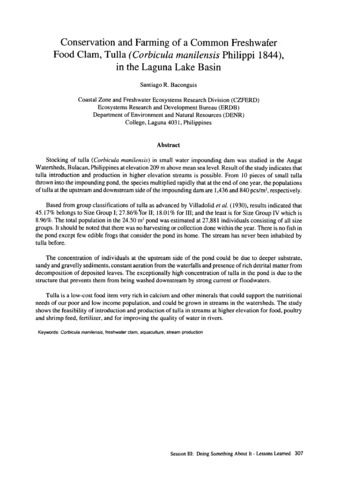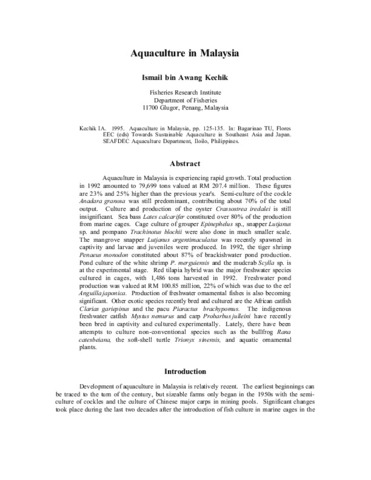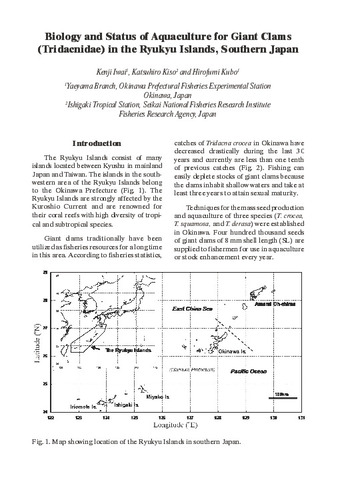Conservation and farming of a common freshwater food clam, tulla (Corbicula manilensis Philippi 1844), in the Laguna Lake basin
- Global styles
- MLA
- Vancouver
- Elsevier - Harvard
- APA
- Help
Share
抄録
Stocking of tulla (Corbicula manilensis) in small water impounding dam was studied in the Angat Watersheds, Bulacan, Philippines at elevation 209 m above mean sea level. Result of the study indicates that tulla introduction and production in higher elevation streams is possible. From 10 pieces of small tulla thrown into the impounding pond, the species multiplied rapidly that at the end of one year, the populations of tulla at the upstream and downstream side of the impounding dam are 1,436 and 840 pcs/m2, respectively.
Based from group classifications of tulla as advanced by Villadolid et al. (1930), results indicated that 45.17% belongs to Size Group I; 27.86% for II; 18.01% for III; and the least is for Size Group IV which is 8.96%. The total population in the 24.50 m2 pond was estimated at 27,881 individuals consisting of all size groups. It should be noted that there was no harvesting or collection done within the year. There is no fish in the pond except few edible frogs that consider the pond its home. The stream has never been inhabited by tulla before.
The concentration of individuals at the upstream side of the pond could be due to deeper substrate, sandy and gravelly sediments, constant aeration from the waterfalls and presence of rich detrital matter from decomposition of deposited leaves. The exceptionally high concentration of tulla in the pond is due to the structure that prevents them from being washed downstream by strong current or flood waters.
Tulla is a low-cost food item very rich in calcium and other minerals that could support the nutritional needs of our poor and low income population, and could be grown in streams in the watersheds. The study shows the feasibility of introduction and production of tulla in streams at higher elevation for food, poultry and shrimp feed, fertilizer, and for improving the quality of water in rivers.
記述
Abstract only.
Suggested Citation
Baconguis, S. R. (2005). Conservation and farming of a common freshwater food clam, tulla (Corbicula manilensis Philippi 1844), in the Laguna Lake basin. In M. L. Cuvin-Aralar, R. S. Punongbayan, A. Santos-Borja, L. V. Castillo, E. V. Manalili, & M. M. Mendoza (Eds.), Proceedings of the First National Congress on Philippine Lakes (p. 307). Southeast Asian Regional Center for Graduate Study and Research in Agriculture (SEARCA).
Type
Conference paperISSN
1656-8099Collections
- LakeCon2003 [49]
Related items
Showing items related by title, author, creator and subject.
-
Aquaculture development in Thailand
Sirikul, Boonsong; Luanprida, Somsak; Chaiyakam, Kanit; Sriprasert, Revadee (Aquaculture Department, Southeast Asian Fisheries Development Center, 1988)Aquaculture practised in Thailand is in the form of pond culture and cage culture in freshwater, brackishwater and coastal areas. The main species cultured include freshwater prawns, brackishwater shrimp, cockles, mussels, ... -
Aquaculture in Malaysia
Kechik, Ismail bin Awang. (Aquaculture Department, Southeast Asian Fisheries Development Center, 1995)Aquaculture in Malaysia is experiencing rapid growth. Total production in 1992 amounted to 79,699 tons valued at RM 207.4 million. These figures are 23% and 25% higher than the previous year's. Semi-culture of the cockle ... -
Biology and status of aquaculture for giant clams (Tridacnidae) in the Ryukyu Islands, southern Japan
Iwai, Kenji; Kiso, Katsuhiro; Kubo, Hirofumi (Aquaculture Department, Southeast Asian Fisheries Development Center, 2006)The Ryukyu Islands consist of many islands located between Kyushu in mainland Japan and Taiwan. The islands in the south-western area of the Ryukyu Islands belong to the Okinawa Prefecture. The Ryukyu Islands are strongly ...






